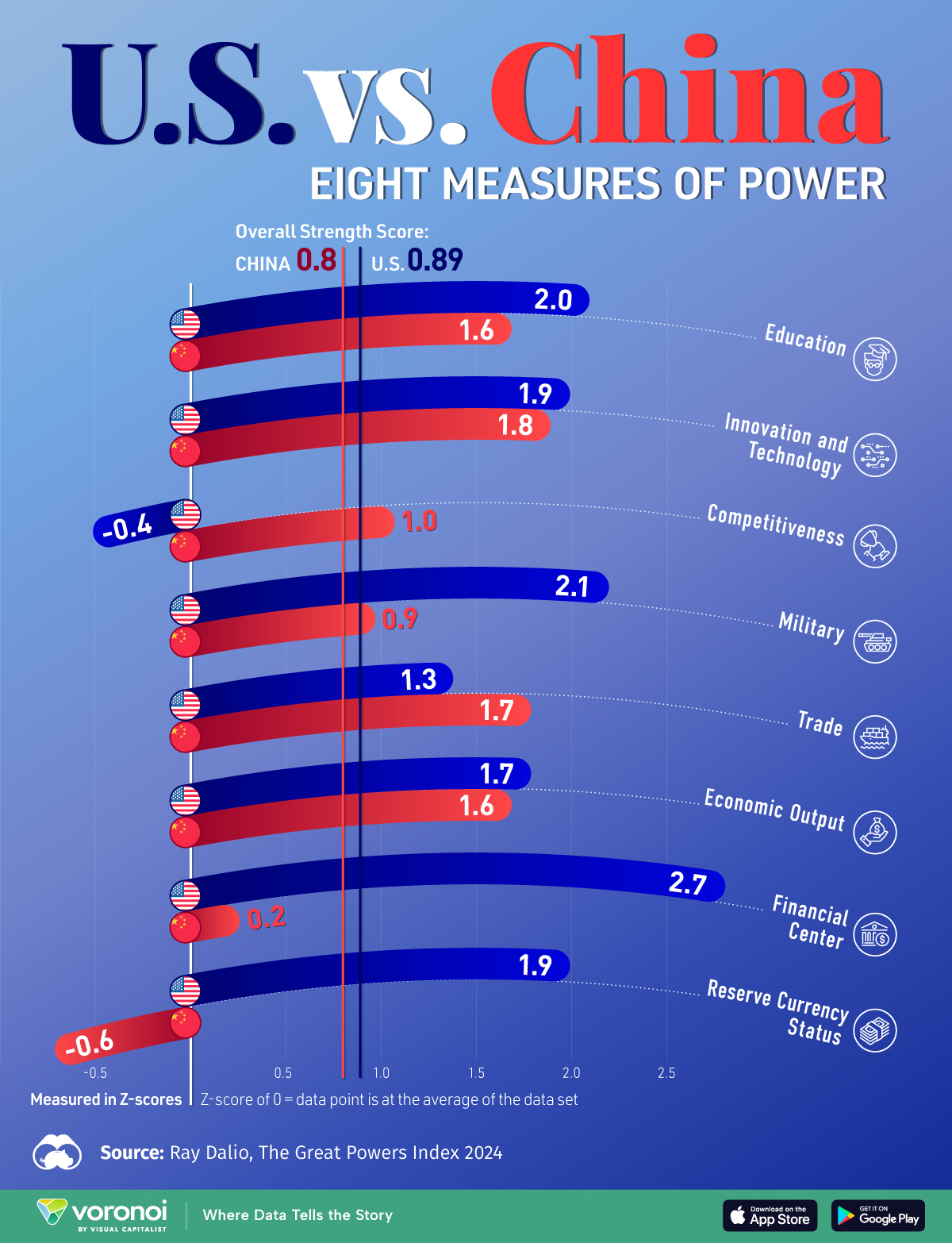Dorothy Neufeld
2024-09-26 12:14:15
www.visualcapitalist.com
![]() See this visualization first on the Voronoi app.
See this visualization first on the Voronoi app.
Comparing the U.S. and China on Eight Measures of Power
This was originally posted on our Voronoi app. Download the app for free on iOS or Android and discover incredible data-driven charts from a variety of trusted sources.
Today, the global balance of power is shaped by many forces, including economic strength, trade, and a country’s defense-industrial base.
While the U.S. and China stand as two great powers, their sources of strength vary significantly. America has unrivaled status in capital markets, and its reserve currency status shows little sign of being overtaken anytime soon. Meanwhile, China’s influence in international trade has grown substantially, now being the top trading partner for 120 countries worldwide.
This graphic compares the U.S. and China across eight key measures of power, based on analysis from Ray Dalio’s Great Powers Index 2024.
Methodology: Measuring the Strength of Nations
For this analysis, Ray Dalio identified eight core pillars that measure a nation’s different types of strength. These eight categories are:
- Trade
- Innovation and Technology
- Education
- Economic Output
- Military
- Financial Center
- Competitiveness
- Reserve Currency Status
Scores for these categories were quantified using Z-scores, which tells you how far a data point is from the average of the dataset, using the typical amount of variation (a standard deviation) in the data as a measuring stick:
- Z-score of 0 = data point is at the average
- Z-score of 1 = data point is one standard deviation above the average
Is the U.S. or China More Powerful?
Below, we show how the U.S. and China measure across each metric of country power in 2024, along with their overall strength score which sees the U.S. (0.89 overall strength score) beat out China (0.80 overall strength score):
| Key Eight Measures of Power |  U.S. Score U.S. Score |
 China Score China Score |
|---|---|---|
| Education | 2.0 | 1.6 |
| Innovation and Technology | 1.9 | 1.8 |
| Competitiveness | -0.4 | 1.0 |
| Military | 2.1 | 0.9 |
| Trade | 1.3 | 1.7 |
| Economic Output | 1.7 | 1.6 |
| Financial Center | 2.7 | 0.2 |
| Reserve Currency Status | 1.9 | -0.6 |
| Overall Strength Score | 0.89 | 0.80 |
As we can see, both countries are closely matched across certain metrics like innovation and technology along with economic output, while also featuring wide differences in categories like reserve currency status and overall competitiveness.
When looking at tech and innovation, America is home to the world’s largest tech companies driving AI advancements, China is quickly developing much of the intellectual property in new industries such as semiconductors, electric vehicles, and advanced manufacturing.
In terms of economic output and strength, the gap between America and China’s GDP stands at about $10 trillion. China could overtake America’s economy by 2035 assuming 5% in annual GDP growth, however, Ray Dalio’s own estimates of 10-year real GDP growth have China at 4% annual growth. The country’s fragile property sector and weak consumer demand are its biggest obstacles for its future growth prospects.
Comparing education, while America’s stagnating high-school educational system is a source of concern, its top-ranking universities play a key role in its education score. Meanwhile, China is home to 100 elite universities, although it too has an unequal education system that disproportionately impacts lower-income households.
When it comes to military power, the U.S. has long being a global leader in defense spending, outpacing China by more than twofold as of 2022. Yet, this position is deteriorating. Today, China’s military modernization means that its defense capabilities are neck and neck with America, and perhaps even greater than the U.S. according to sources like the Global Firepower Index.
Moreover, China is increasingly growing alliances with Russia, Iran, and North Korea through arms transfers and battlefield exercises, posing a greater risk to America’s military dominance.
Learn More on the Voronoi App 
To learn more about this topic from a labor force perspective, check out this graphic on the growth of working age populations around the world’s major economies.
The post U.S. vs. China: Which Country is the World’s #1 Superpower? appeared first on Visual Capitalist.
Support Techcratic
If you find value in Techcratic’s insights and articles, consider supporting us with Bitcoin. Your support helps me, as a solo operator, continue delivering high-quality content while managing all the technical aspects, from server maintenance to blog writing, future updates, and improvements. Support Innovation! Thank you.
Bitcoin Address:
bc1qlszw7elx2qahjwvaryh0tkgg8y68enw30gpvge
Please verify this address before sending funds.
Bitcoin QR Code
Simply scan the QR code below to support Techcratic.

Please read the Privacy and Security Disclaimer on how Techcratic handles your support.
Disclaimer: As an Amazon Associate, Techcratic may earn from qualifying purchases.
























































![Japanese Movie – The X From Outer Space (Uchu Dai Kaijyu Girara) [Japan BD] SHBR-263](https://techcratic.com/wp-content/uploads/2024/11/81rV3BDVGJL._SL1024_-360x180.jpg)












